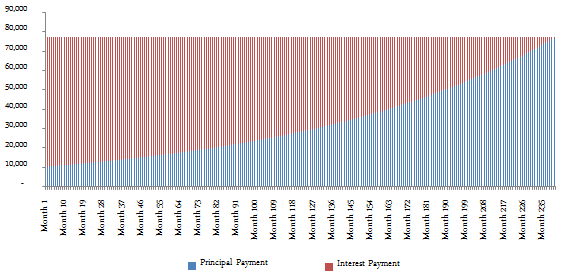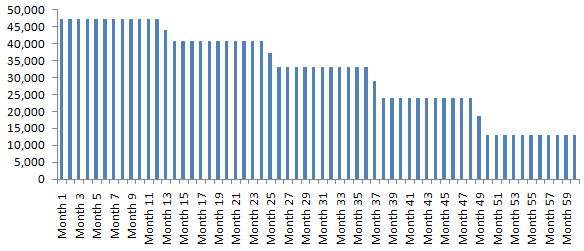Cost of debt is huge and can be damaging to our financial future: Part 2

In the first part of this two part series, we discussed how debt comes in different forms. More often than not we are not even aware of the huge cost of debt. We also discussed the potential opportunity loss, if you rely on debt to meet your lifestyle aspirations. In this part, we will discuss the cost of home loans, usually the biggest debt component of average urban middle income to upper middle income households.
The cost of home loan is huge and many households are not even aware about the magnitude of the cost. The cost is huge for three reasons. Home loans are multiple times larger compared to other classes of household debts. The tenure of a home loan is multiple times that of a car loan and other classes of household debt. Longer the tenure of a loan, higher is the interest paid over the tenure. Interest rates in India are much higher than rental yields (we will discuss more on this later). Current rate of interest on home loans range from 9.5% to 11%.
Let us understand the cost of home loan with the help of an example. Let us assume you have taken a 20 year floating rate home loan of र 75 lakhs to buy an apartment. The current interest rate is 10%. The EMI of your car loan will work out to be approximately र 72,400. The interest rate may go down in the future, but you have to understand that just because RBI cuts repo rate by 25 bps, you cannot expect your bank / lender to also reduce your home loan interest rate by 25 bps. Banks reduce home loan interest rate with a considerable amount of lag and many a times, they may not even reduce rates even if the RBI reduces the repo rate. You further have to realize that, interest rates follow cycles, and over a very long tenures (20 years or so), interest rates are as likely to go both up at times and go down at times. It is very difficult, if not impossible, to predict, what average home loan interest rate will be over the next 20 years, but for the sake of our example, let us assume the average interest rate over the entire tenure is 10%. The chart below shows the principal and interest payments made over the loan tenure.

How much interest will you have to pay through the tenure of your home loan? You can see that, for the first 10 years of your tenure, a big portion of your monthly EMIs go towards servicing simply the interest. In fact, in the first 8 years of your home loan 80% of the EMIs, on average, go to interest payments and only 20% to principal payment. Over the tenure of the loan, interest payment will be approximately र 1 crore, which is much more than the purchase price of the house.
Please remember that, we are just discussing interest costs. If you are staying in rented house and your builder delays possession of your home by a few years, which based on the experience of home buyers over the last many years, is a very likely scenario, you will be bearing double costs, both the rent and the EMI.
Waiting to purchase a home and making more profitable investments makes more sense
Home purchase is, for most of us, an emotional decision. It is definitely more emotionally satisfying for many Indians, to live in your own house compared to living in a rented house. In Advisorkhoj, we respect emotions, but we also want the readers to be objective and analytical, when they are making their financial decisions. The reality is that, rental yields in India are among the lowest in the world.
As per a study done by Jones Lang LaSalle, a globally renowned real estate consultancy firm, rental yields in India are between 2 – 4% per annum only. In New Delhi it is around 2% only, while in Mumbai it is around 3.5%. You should compare rental yields with home loan interest rates, 9.5 – 11%.
Let us understand the implications of this, through an example. If you are renting an apartment, value of which is र 1 crore, your annual rent will be र 2 – 4 lakhs only; your monthly rent will be र 20,000 to 35,000 approximately. If you bought the same house, making a 20% down payment and took a home loan to pay the balance amount, your EMI will be र 77,200 and your monthly interest payment will range from र 60,000 to 67,000 for the first five years. Purely, from a financial viewpoint, it simply makes sense to stay in a rented apartment. Real estate agents will tell you that your property will appreciate in value. It is fair point, but let us be clear about the purpose of your property investment. Are buying the property to live in it, or purely for investment? If you are buying a property so that you and family can live in it, capital appreciation is irrelevant, is it not?
Let us now do a bit of mathematics. Let us assume you are currently paying a monthly rent of र 30,000. Let us assume your landlord increases the rent by 10% every year. Now compare your rent, with your monthly EMI if you bought the house with a 20 year, 10% interest home loan. The chart below shows your monthly savings over the first 5 years.

Vast majority of the savings that you make in this example is simply on account of the difference between interest rates and rental yields. If you invest the savings made every month in an equity mutual fund over 5 years, you will accumulate around र 31 lakhs, assuming 15% rate of return.
Further, if you stayed in a rented place and did not have to make the 20% down payment for the house from your savings, you can invest the amount of savings to the extent of the down payment in an equity mutual fund and earn returns on that too. If we add the savings on both the down payment and monthly savings due to difference in interest rate and rental yield, you will accumulate a total corpus of more र 71 lakhs in 5 years. You may desire to live in your house rather than in a rented house. Earlier in the example we saw that, if you bought a house right now, you could have made a down payment of र 20 lakhs, but if you wait for five years and invest your savings in good mutual fund schemes, you can use the accumulated corpus to make a much bigger down payment, र 71 lakhs. Bigger the down payment less is your interest burden.
Your real estate broker will tell you, if you do not buy right now, property price will increase. It is quite likely that, property price will increase in 5 years, but the more important question is, by how much? Let us go with facts. Given that real estate is a prominent part of household assets, National Housing Board constructed a residential property price index called Residex to track the movement of real estate prices across different cities. If we take Residex data as a broad directional indicator of real estate, from 2007 to 2015, housing price in Mumbai grew at a CAGR of 11.4%. Among the 5 metros, from 2007 to 2015, housing price growth in Bengaluru was the lowest (1.8% CAGR), while that in Chennai was the highest (17.5% CAGR). Housing prices in Delhi and Kolkata grew at CAGRs of 8.4% and 9.8% respectively.
Obviously, the increase in property price will depend on the location, but for the purpose of this post, let us go with the Mumbai Residex data and assume property price inflation at a CAGR of 11% over the next 5 years. The property which is valued at र 1 crore today will cost र 1.68 crores in 5 years, assuming 11% CAGR inflation. But if you are able to make a down payment of र 71 lakhs for a property worth र 1.68 crores, that represents 42% of the total cost of the property, as opposed to 20%, if you made a down payment of र 20 lakhs for a property worth र 1 crore today. The economic benefits may not be obvious to some of our readers.
Let us illustrate with numbers. For one, even if you made a down payment of र 71 lakhs for a property worth र 1.68 crores, you still have to take a loan of र 97 lakhs, as opposed to र 80 lakhs if you bought the house by taking a home loan today. A higher loan amount will mean higher EMIs. If you took a 20 year र 97 lakhs home loan @ 10% interest, your EMI will be around र 94,000. This is obviously higher than the EMI of around र 77,200 on र 80 lakhs home loan if you were to take it now, a 22% increase. Does it mean that, you are better off buying the house now? No.
You should evaluate how much home loan EMI you have to pay as a percentage of your monthly income. Assuming you get an annual increment of 10%, your income in 5 years will increase by 61%. Compare your increase in income with the increase in EMI. The increase in your income is much more than increase in your EMI. Therefore, you will be able to save, a much bigger portion of your salary for other long term financial objectives in this example, if you defer your property purchase by a few years.
We have seen the math, but let us understand the financial / economic rationale behind, why deferring a home loan decision makes more sense. There are two simple reasons. One, as discussed earlier, the rental yield of a property is much lower than the interest rate. Second, on a historical basis, equity is a superior asset class compared to real estate, as far as long term returns are concerned.
Conclusion
In this two part series, we have discussed that, debt has a cost associated with it. More often than not, many households do not understand the magnitude of the cost associated with debt. Many a times, we purchase something thinking it to be an asset. If we go by strict finance definition, an asset is something which gives future cash flows. By spending on credit cards or even buying a vehicle, you are not creating an asset. If you are buying a house, whether for the purpose of living there, renting it out or purely speculative for resale profits, you are potentially buying an asset. The main question in that case is, what is the cost of the asset purchase, if financed through a loan, and whether the return on investment is more than the cost. If you are a rational investor, you should do a rigorous cost benefit analysis, before you take a loan.
Mutual Fund Investments are subject to market risk, read all scheme related documents carefully.
RECOMMENDED READS
LATEST ARTICLES
- Why you need to have hybrid mutual funds in your portfolio: Different types of funds Part 2
- Why you need to have hybrid mutual funds in your portfolio: Misconceptions Part 1
- Which is the best time to invest in mutual funds
- Economic slowdown: Is it real and what should you do
- Importance of liquidity in investing: Mutual funds are ideal solutions
An Investor Education Initiative by ICICI Prudential Mutual Fund to help you make informed investment decisions.
Quick Links
Follow ICICI Pru MF
More About ICICI Pru MF
POST A QUERY




